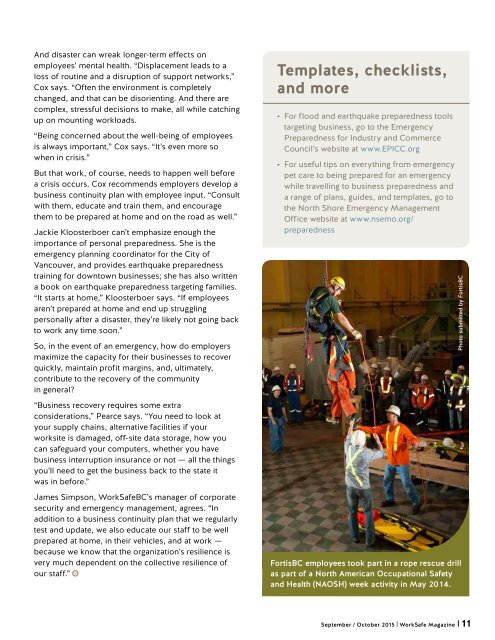WorkSafe
ZUJe3
ZUJe3
Create successful ePaper yourself
Turn your PDF publications into a flip-book with our unique Google optimized e-Paper software.
And disaster can wreak longer-term effects on<br />
employees’ mental health. “Displacement leads to a<br />
loss of routine and a disruption of support networks,”<br />
Cox says. “Often the environment is completely<br />
changed, and that can be disorienting. And there are<br />
complex, stressful decisions to make, all while catching<br />
up on mounting workloads.<br />
“Being concerned about the well-being of employees<br />
is always important,” Cox says. “It’s even more so<br />
when in crisis.”<br />
But that work, of course, needs to happen well before<br />
a crisis occurs. Cox recommends employers develop a<br />
business continuity plan with employee input. “Consult<br />
with them, educate and train them, and encourage<br />
them to be prepared at home and on the road as well.”<br />
Jackie Kloosterboer can’t emphasize enough the<br />
importance of personal preparedness. She is the<br />
emergency planning coordinator for the City of<br />
Vancouver, and provides earthquake preparedness<br />
training for downtown businesses; she has also written<br />
a book on earthquake preparedness targeting families.<br />
“It starts at home,” Kloosterboer says. “If employees<br />
aren’t prepared at home and end up struggling<br />
personally after a disaster, they’re likely not going back<br />
to work any time soon.”<br />
So, in the event of an emergency, how do employers<br />
maximize the capacity for their businesses to recover<br />
quickly, maintain profit margins, and, ultimately,<br />
contribute to the recovery of the community<br />
in general?<br />
“Business recovery requires some extra<br />
considerations,” Pearce says. “You need to look at<br />
your supply chains, alternative facilities if your<br />
worksite is damaged, off-site data storage, how you<br />
can safeguard your computers, whether you have<br />
business interruption insurance or not — all the things<br />
you’ll need to get the business back to the state it<br />
was in before.”<br />
James Simpson, <strong>WorkSafe</strong>BC’s manager of corporate<br />
security and emergency management, agrees. “In<br />
addition to a business continuity plan that we regularly<br />
test and update, we also educate our staff to be well<br />
prepared at home, in their vehicles, and at work —<br />
because we know that the organization’s resilience is<br />
very much dependent on the collective resilience of<br />
our staff.” W<br />
Templates, checklists,<br />
and more<br />
• For flood and earthquake preparedness tools<br />
targeting business, go to the Emergency<br />
Preparedness for Industry and Commerce<br />
Council’s website at www.EPICC.org<br />
• For useful tips on everything from emergency<br />
pet care to being prepared for an emergency<br />
while travelling to business preparedness and<br />
a range of plans, guides, and templates, go to<br />
the North Shore Emergency Management<br />
Office website at www.nsemo.org/<br />
preparedness<br />
FortisBC employees took part in a rope rescue drill<br />
as part of a North American Occupational Safety<br />
and Health (NAOSH) week activity in May 2014.<br />
Photo submitted by FortisBC<br />
September / October 2015 | <strong>WorkSafe</strong> Magazine 11


